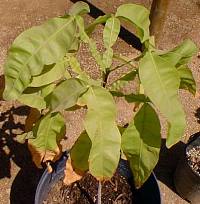Spanish Lime, Genip, Quenepa, Mamoncillo
Scientific Name: Melicoccus bijugatus Jacq.
Synonym: Melicocca bijuga
Family: Sapindaceae
Sunset®: 23-26
USDA: 10
Frost Tolerance: Tender in Phoenix, foliage damaged at 32° F (0° C), serious damage at 25° F (-6° C)
Sun Exposure: Full sun
Origin: Central America, Nicaragua to Colombia, Caribbean
Growth Habits: Medium sized to large tree, up to 100 feet tall (30 m)
Watering Needs: Occasional deep watering in summer for established plants
Propagation: Seeds, approach grafting
This tropical American tree is widely cultivated in the West Indies for its fruit. It is a medium-sized to large tree and is often planted along roadsides.
Blooming Habits:
The small, greenish-white, fragrant flowers are borne in panicles from the branch tips at the beginning of the rainy season. The tree generally are polygamous, that is , they produce both bisexual flowers and those of one sex only. The anthers of many bisexual flowers are non-functional so that fruits do not develop unless cross-pollination occurs. Care should be taken, therefore, to set out plants with flowers of each sex.
Fruiting Habits:
In Puerto Rico, the fruit ripens from July to September, appearing like bunches of large, green grapes. These are cut and peddled widely along roadsides and streets.
The ovoid fruit measures a little over 1 inch in length, but an occasional tree bears fruit twice this size. Inside the tight, thin skin, which is easily cracked by the teeth, lies a thin layer of sweet-tart yellow pulp surrounding a large ovoid seed. This pulp is a good source of iron. The seeds are said to be edible after roasting.
Propagation:
Propagation is by seeds, but selected varieties can be propagated by approach grafting.
Desert-Tropicals is dedicated to provide gardening advice, gardening ideas, and information about flower of all kind for landscape and collections.We try to check carefully the identification of the plants on the illustrations as well as the other information from the page, but occasionally errors do occur. if you notice anything that needs to be changed please contact us.Thanks.
© 1998-2020 Philippe Faucon, All Rights Reserved.
